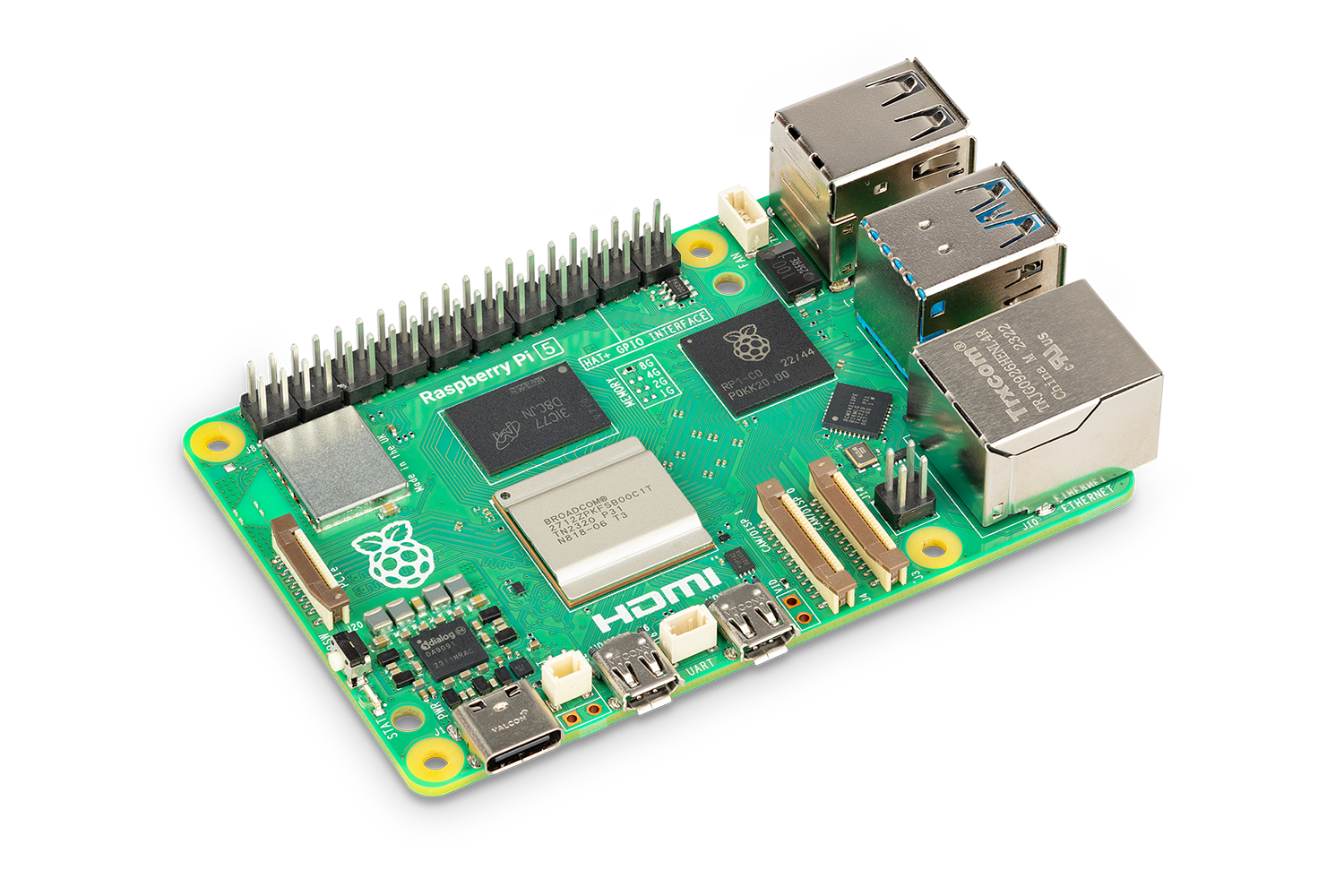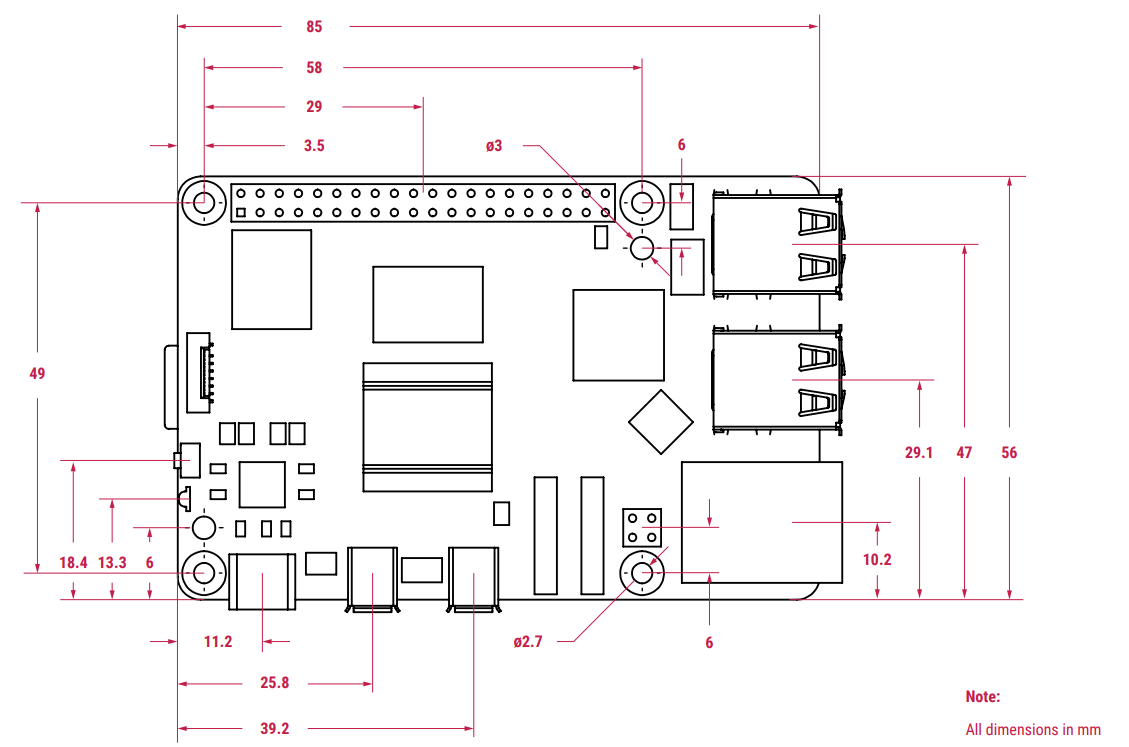After seven years of relentless research and development, discover the all-new Raspberry Pi 5:
the most powerful Pi board ever created, even closer to the PC!

The latest version of the Raspberry Pi, the Raspberry Pi 5, has finally been unveiled, four years after the launch of the Raspberry Pi 4.
Fully exploiting the strengths of its predecessor, the Raspberry Pi 5 boasts a significant performance improvement, offering a 3x increase in processor performance, all at a starting price of €70!
Notable improvements, in detail:
CPU improvements
The latest addition to the range proudly sports the brand-new Broadcom BCM2712 chip, marking a significant advance on the BCM2711 that equipped its predecessor. The Pi 5's processor upgrade features a quad-core Cortex-A76 (ARVM v8) processor running at 2.4 GHz (16nm), a significant improvement over the Pi 4's quad-core Cortex-A72, which ran at 1.8 GHz. Enhanced processing power for up to 3 times the performance! This CPU features two 64KB L1 caches (data and instructions), a 512KB L2 cache for each core. Finally, a 2MB L3 cache is shared between all cores.
GPU enhancements
The GPU is upgraded from VideoCore VI at 800 MHz (Pi 4) to VideoCore VII at 1.1 GHz (Pi 5, VideoCore VII). At a frequency of 1 GHz, the VideoCore VII boasts a performance improvement of 2 to 2.5 times over its previous generation. This translates into the ability to achieve a higher refresh rate (IPS). Thanks to this increase in power, the Pi 5 can support smooth display on two 4K screens simultaneously, with no loss of quality!
Improved memory
As for RAM, it's LPDDR4X instead of DDR4. LPDDR4X is a low-power form of RAM, operating in a voltage range from 0.6V to 1.1V. The suffix "X" indicates that the clock frequency used can reach 4267 MHz (or 4.16 GHz). The Pi 5 has an advantage thanks to its LPDDR4X-4267 SDRAM, which offers higher speed than the Pi 4's LPDDR4-3200 SDRAM. The Foundation has included an indicator to make it easier to recognize the RAM (4 or 8GB) present on the Raspberry Pi.
Display enhancements
The Raspberry Pi 5 offers impressive display support thanks to its two HDMI 2.0 outputs, each capable of broadcasting in 4K at 60 Hz. The Pi 4 also has two HDMI 2.0 ports, but one is limited to 30 Hz resolution, unlike the other, which supports 4K at 60 Hz.
What's more, the Raspberry Pi 5 supports the H.265 codec, offering clear advantages in terms of compression efficiency and video quality over the Pi 4's H.264.
Equipped with a 4-channel MIPI interface, the Pi 5 is better suited to applications requiring higher data rates, such as high-definition video and high-resolution images, compared with the 2-channel MPIPI interface present on the Pi 4.
New features
Like the long-awaited ON/OFF button or PCIe 2.0 port, as well as integrated RTC connector to exploit even more possibilities and enhancements
Features :
- Broadcom BCM2712 chip with 2.4 GHz quad-core ARM Cortex-A76 (ARM v8 - 64-bit) processor, with 512KB L2 cache and 2MB shared L3 cache
- VideoCore VII GPU, compatible with OpenGL ES 3.1, Vulkan 1.2 - 800 Mhz
- 4GB or 8GB SDRAM LPDDR4X-4267 (depending on version)
- ON/OFF power button
- 5V/5A DC power supply via USB-C (reduced compatibility with Official Power Supply for Raspberry Pi 4 15.3W USB*)
CONNECTIONS
- PCIe 2.0 interface with 16-pin 0.50 mm FFC connector (requires independently controlled FFC)
- 2x Micro-HDMI® 4Kp60 ports with HDR support, lossless simulcast and integrated 4Kp60 HEVC decoder
- Micro-SD port, with support for high-speed mode (SDR104)
- 2x USB 3.0 ports up to 5Gbps simultaneously
- 2x USB 2.0 ports
- 40x GPIO pins
- 2x 4-way MIPI DSI (display) / CSI (camera) connectors
- x2 Connectors for (Use of a fan is strongly recommended for Raspberry Pi 5**)
- RTC connector for official real-time clock
NETWORKS
- Gigabit Ehternet with PoE+ support (requires PoE+ HAT not included)
- Dual-band Wi-Fi 802.11ac
- Bluetooth 5.0 / Bluetooth Low Energy (BLE)
SOLDERING & IDENTIFICATION
- "Intrusive reflow" technology: soldering seams on the rear panel are not visible
- Each Raspberry Pi 5 carries a unique identification number printed directly on the card and on the individual packaging
- The RAM power of the Raspberry Pi 5 is now directly indicated via a small insert and a solder joint on the top of the board
Board diagram :

Technical dimensions :

The Raspberry Pi 5 is a remarkable successor to the Raspberry Pi 4, bringing appreciable improvements in terms of performance and connectivity!
Kubii offers Raspberry Pi 5 in board-only and kit versions, as well as all official accessories. Whether you're a beginner, an enthusiast, a maker or a seasoned enthusiast, the Raspberry Pi 5 has the potential to revolutionize your projects and open up new possibilities.


 Français
Français
 Español
Español
 Italiano
Italiano
 Deutsch
Deutsch